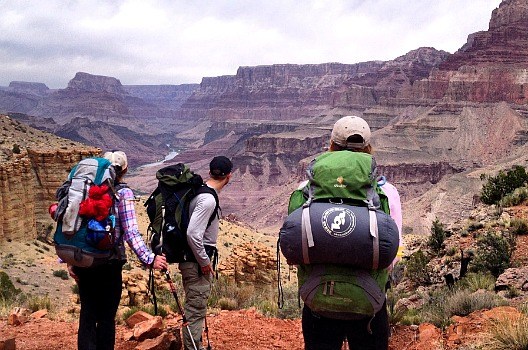
The Grand Canyon has been a source of wonder since the first pair of eyes gazed upon it. Many who make the trek to visit Grand Canyon want to have an immersive experience by using a guide. Guides provide safety and hold an immense amount of knowledge about this environment. This profession has become extremely valuable but many people are unaware of the evolution of guiding in the canyon.

Humans have been a part of Grand Canyon’s history for over 10,000 years. The Havasupai, Hualapai, Navajo, Hopi, Zuni, and Paiute have called the Grand Canyon region home for hundreds of years. They lived around and in the canyon leaving behind dwellings, food storage, and artifacts for later travelers to find. Native tribes occupied these lands and are still present within and outside of the park.
The first people to guide others into the canyon were Native Americans. On September 1540, under orders from the conquistador Francisco Vázquez de Coronado, Captain García López de Cárdenas came to the Southwest to search for the fabled Seven Cities of Cibola. Hopi guides and a small group of Spanish soldiers traveled to the south rim of the Grand Canyon between Desert View and Moran Point. After descending some one third of the way into the canyon, they were forced to return because of lack of water. No Europeans visited the canyon again for more than two hundred years.

Joseph Christmas Ives is credited as the first European American known to reach the river within Grand Canyon in 1857. On a expedition for the US Army corps of Topographical Engineers, Luitenent Ives powered up the Colorado River in a steamboat, intending to make it through the entire Canyon. Although they only made it to just below (now) Hoover Dam in the steamboat, they continued on foot through the canyon. He said the of canyon “The region is, of course, altogether valueless ….after entering it there is nothing to do but leave. Ours has been the first, and will doubtless be the last, party of whites to visit this profitless locality. It seems intended by nature that the Colorado river, along the greater portion of its lonely and majestic way, shall be forever unvisited and undisturbed.” He was wrong.
John Wesley Powell made the incredible expedition in 1869 into the Colorado River. He published The Exploration of the Colorado River of the West and its Tributaries which describes his exploration into Grand Canyon. The bravery of Powell and his crew shed light onto this unknown landscape and was a catalyst for adventurers and seekers around the world.

The Santa Fe Railroad started bringing visitors to the canyon’s South Rim in 1901. For many business was booming! Creative entrepreneurs, like Fred Harvey, came to make their fortune at the canyon selling goods and hospitality services to visitors. This foundation is what allows millions of people make their way to the Grand Canyon every year.

Many consider the first commercial tour guide to be John Hance. He is known as Grand Canyon’s first permanent European-American settler possibly arriving in 1883. As the twentieth century approached, the South Rim of Grand Canyon saw increasing commercial development, with stagecoaches and railroads carrying hundreds of people to the rim every year. Realizing the opportunity, John Hance traded mining for gold for a life of guiding. As tourism increased so did his popularity. Hance would to lead visitors down into the canyon and tell tall tales of how he dug the canyon himself. His guiding became so popular that when President Theodore Roosevelt came to Grand Canyon in 1903, it was John Hance who led him down the trail.
In 1972 over 16,000 people floated along the Colorado River. The National Park Service realized that tourism was still rising and the demand for guided experiences were increasing. Though it can be difficult to obtain a permit for certain trips, due to the rise in tourism there are now many ways people can experience Grand Canyon! You can ride on the back of a mule, hike with a guide, ride in a colorful jeep, or raft along the river. Guides are excellent sources of information and education about the history within the canyon walls. It is important to remember that experiencing a guided trip would not be possible if it wasn’t for Native Americans guiding the first explorers, John Powell and his men exploring the might Colorado, Fred Harvey and his hospitality services, and the tall tales of John Hance.


